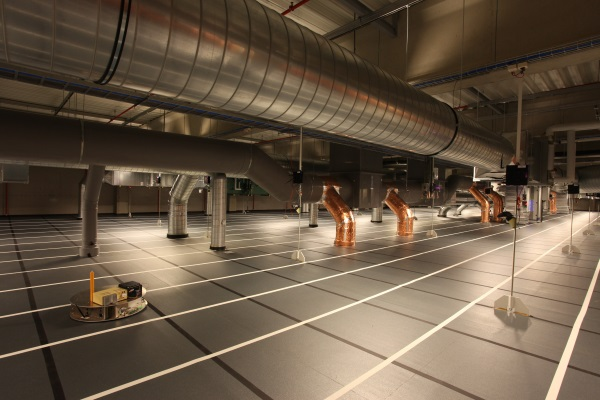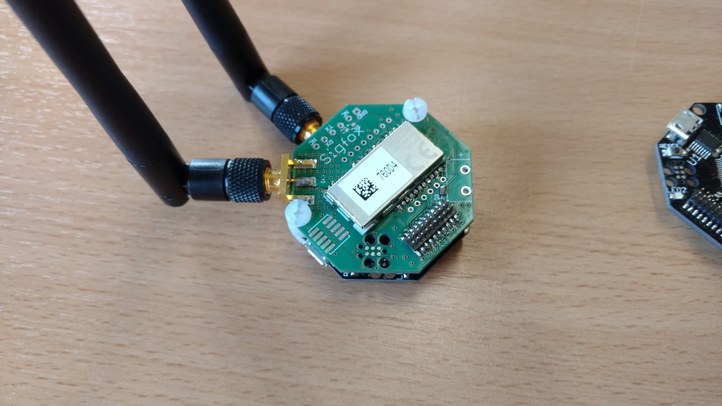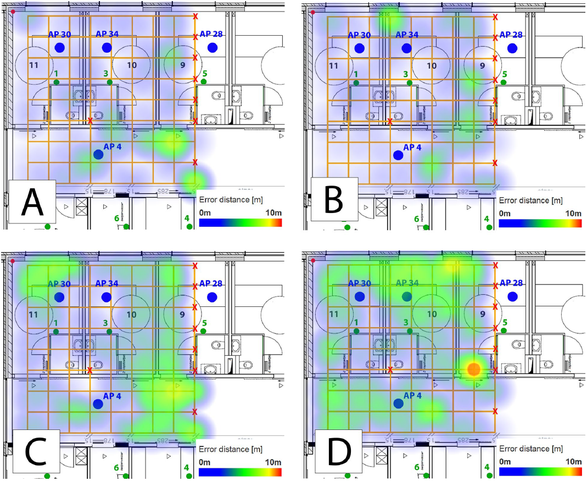Localization and Tracking
In recent years, location-based information has become indispensable in multiple application domains including, amongst others, agriculture, healthcare, factory automation, warehousing, retails and logistics. To enable innovative indoor-localization applications, this research track focusses on three aspects: (i) localization system validation and benchmarking, (ii) multi-modal localization and (iii) scalability of localization solutions in harsh environments.
Localization system validation and benchmarking
Over the last few years, the number of indoor localization solutions has grown exponentially, and a wide variety of different technologies and approaches are being explored. Consequently, it is currently extremely hard to objectively compare the performance of multiple localization solutions with each other. To address the problem, we use large scale testbeds and in-situ measurements for automated evaluation and comparison of localization solutions in different environments using standardized ISO/IEC 18305 evaluation metrics, allowing unique insights in the overall localization system behavior in different conditions.
Multi-modal localization
Localization solutions often exhibit good performance in a subset of conditions. To cope with the inherent trade-offs of different localization approaches (e.g. in terms of energy consumption, accuracy, update ratio, etc.), multi-modal localization solutions combine multiple, heterogeneous localization approaches to improve overall performance. Some examples include the following.
- Multimodal localization allows a smooth transition between indoor and outdoor by selecting the most appropriate network to perform the localization. Mid-range technologies can provide more accurate localization indoor, while long range technologies enable coverage outdoor.
- Infrastructure less localization approaches utilize pre-deployed devices rather than on-board calculations to localize devices. If the localization is handled by the network, the device itself can focus its resources on other tasks, saving energy when infrastructure is available, and switching to other approaches when necessary.
For this purpose, IEEE 802.15.4, Wi-Fi, BLE, DASH7, UWB and RFID are being used as enabling technologies, both with commercial hardware as specific designed prototypes.
Scalability in harsh environments.
Localization solutions found in current scientific literature often analyze the performance using small scale experiments (only one mobile tag) in simple & unrealistic (often line-of-sight) conditions. As a result, there is currently a gap between many research efforts reported in scientific literature and the innovations that are required to cope with actual industry needs. A leap of knowledge is required to cope with the industry needs for improved scalability (e.g. density and coverage), for realizing these high accuracies in realistic environments and conditions, as well as to easily install and deploy localization solutions. To overcome these shortcomings, our research includes innovative beyond the state of the art solutions to
- improve localization scalability and coverage to simultaneously localize hundreds of users in (indoor) areas of multiple square kilometers;
- co-design localization & communication MAC protocols to combine multi-hop communication streams with localization capabilities;
- support easy deployment and self-configuration of localization solutions;
- provide accurate localization even during challenging activities (e.g. sporters, fireman, rescue operations, ...) and in harsh conditions (industrial environments with metal obstacles & interference).
Staff
Eli De Poorter & Maarten Weyn
Researchers
Ben Bellekens, Rafael Berkvens, Noori Bni Lam, Stijn Denis, Glenn Ergeerts, Matteo Ridolfi, Jen Rossey, Jetmir Haxhibeqiri, Abdulkadir Karaagac.
Projects
- ICON iFEST - improved festival experience through wireless
- City of Things platform
- ICON LUNAR - Retail industry localization based on ultra wideband technology
- ICON MoniCow: More Efficient Cattle Monitoring Through an Advanced Data System
- ICON HYCOWARE : Hybrid Connected Warehouses
- VIS Mechatronics 4.0 - Towards connected, autonomous industrial machines
- FP7 EVARILOS - Evaluation of RF based localization solutions for the future internet
Key publications
- T. Van Haute, E. De Poorter, F. Lemic, V. Handziski, N. Wirstrym, T. Voigt, A. Wolisz and I. Moerman, “Platform for Benchmarking of RF-Based Indoor Localization Solutions”, IEEE Communications Magazine (Volume: 53, Issue: 9, September 2015)
- Ergeerts Glenn, Nikodem Maciej, Subotic Dragan, Surmacz Tomasz, Wojciechowski Bartosz, De Meulenaere Paul and Weyn Maarten, “DASH7 alliance protocol in monitoring applications”, 10th International Conference on P2P, Parallel, Grid, Cloud and Internet Computing (3PGCIC), November 4-6, 2015, Krakow, Poland - ISSN 2334-3079 - Piscataway, N.J., IEEE, 2015, p. 623-628
- T. Van Haute, E. De Poorter, I. Moerman, F. Lemic, V. Handziski, A. Wolisz, N. Wirstrom and T. Voigt, “Comparability of RF-based Indoor Localization Solutions in Heterogeneous Environments: An Experimental Study”, International Journal of Ad Hoc and Ubiquitous Computing, April 2015
- Berkvens Rafael, Weyn Maarten and Peremans Herbert, “Localization performance quantification by conditional entropy”, International Conference on Indoor Positioning and Indoor Navigation, (IPIN), OCT 13-16, 2015, Banff, CANADA - ISSN 2162-7347 - New york, Ieee, (2015)
- T. Van Haute, B. Verbeke, E. De Poorter and I. Moerman, “Optimizing Time of Arrival Localization Solutions for Challenging Industrial Environments”, IEEE Transactions on Industrial Informatics, 2016


